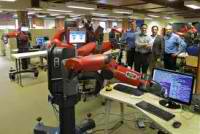In a recent 4 Corners report on digital disruption and future jobs, the underpinning question was, “In the coming age of robotics and advanced IT, what will the jobs of the future be?”
Whilst there were futurists and researchers making predictions and quoting numbers or percentages of jobs that will be lost, this question requires consideration of evidence from workforce planning with employers and industry sectors, a global perspective, and grasp of the impact of new discover technologies on work.
The way to think about this is not that there is a list of ‘good’ jobs vs. ‘bad’ jobs because all jobs will be impacted by robotics, advanced IT and new discovery technologies.
Increasingly into the future, humans willbe working alongside robots, using apps, devices and tools, with artificial intelligence on a higher level and deep machine learning. Much of this though depends on cultural acceptance and perception.
For example, there are robots that can clean houses and premises like hotels or office yet we generally choose to keep people in those roles. Similarly in a country like the USA the #1 job role is truck driver and we already have access to autonomous trucks. And it’s not like overnight we’ll have all of these people in a job and then the next day or week we won’t have any – this will be a gradual shift for most traditional/current job roles. I also suspect that there could be another counter intuitive outcome, where for some people hand-made/hand-crafted, old school or alternative approaches (think the slow movement, mindfulness, vintage/retro) become very niche and cool, says Head Workforce Planner, Wendy Perry, Workforce BluePrint.
The highlights in the full 4 Corners story included students from the Good Shepherd Lutheran School programming robots and comments from Jan Owen at the Foundation for Young Australians on the importance of enterprise skills.
Footage of the Concept and Create Expo at the Australian Science and Maths School (ASMS) demonstrated how students are developing creative thinking, finding problems, designing solutions, integrating subjects like English and STEM into challenge based learning.
Tech companies in the USA (at the SXSW16 job expo) are recruiting for two types or roles – developers and sales. The ability to pitch your ideas, persuade and influence others, get agreement and turn that into an outcome whether its entrepreneurship, intrapreneurship or for social good is one of the new 21st Century capabilities.
Here are examples of 30 jobs where new discovery technologies will augment roles and require 21st Century Capabilities including:
- 3D print technician
- Artificial Intelligence (AI)trainer
- Animation specialist
- Autonomous vehicle engineer
- Bitcoin trader
- Blockchain developer
- Business transformation practitioner
- Chief futurist
- Cloud architect
- Coder artist
- Community/space host
- Creative director
- Cyber security analyst
- Data scientist
- Digital anthropologist
- Drones operator
- Entrepreneur
- Esports commentator
- Internet of Things (IOT) application engineer
- Machine learning scientist
- Network programmer (SDN)
- Neuro implant technician
- Optics hardware engineer
- Platform developer
- Professional triber
- Robotic farmer
- Robotics specialist
- Smart city designer
- Social messaging specialist
- Virtual reality designer
Many jobs are connected to dynamic smart cities, like Austin, Texas and Adelaide City Council all enabled by the Internet of Things (IoT) where the sky is the limit in terms of thinking what might be possible.
From the list above the #1 job roles for career resilience has to be an entrepreneur, able to move with the market, technology and be comfortable with disruption. An example of someone well known in the startup space is Gary Vee:
https://www.youtube.com/watch?v=apXwcYOHAxU
and locally Scott Boocock from HEGS, who together with Jess from Career BluePrint judged the ASMS students inventions at the expo.
Other top picks would be around Artificial Intelligence (AI) and machine learning, for example training robots and designing experiences for the like of Sophia: https://www.youtube.com/watch?v=j_1pS3XKhdY.
AI robots like Sophia could in the future become coaches, mentors, teachers, counsellors, care workers where they learn how to behave and show empathy.
Finding applications and markets for what IBM Watson:
https://www.youtube.com/watch?v=_Xcmh1LQB9I can do with cognitive computing will also mean that current job roles that are knowledge or information based will be transformed where humans will need to value add to insights and apply them in a practical way.
Sectors like retail will change dramatically where products are sold direct to consumers with delivery in an hour and esports is an area to watch with new job roles including esports commentator.
Managing your digital identity with professional personal branding is important as well as how you engage through social messaging as most employers check potential recruits out on social media platforms.
This blog post highlights why that famous quote (from a number of potential original sources), “The best way to predict the future is to create it”, is true for workforce planning and development at the enterprise level, for industry sectors, regions and countries.
July 2016

